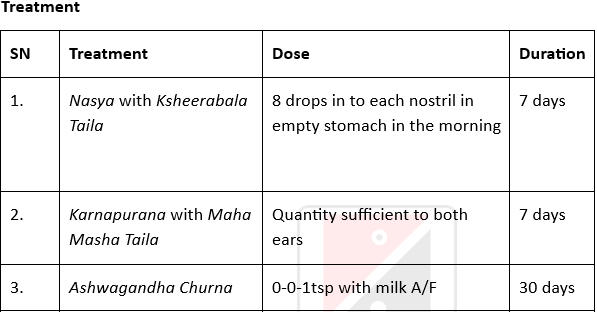Effective management of Karnanada (Tinnitus) - A Clinical Case Study
DOI:
https://doi.org/10.21760/jaims.10.9.58Keywords:
Karnanada, Tinnitus, Nasya, KarnapuranaAbstract
Shalakya Tantra is one among the eight branches of Ayurveda wherein Karnaroga (ear diseases) has been discussed in detail. The Acharyas describe 28 types of Karna Roga, among which one of the diseases is Karnanada[1], characterised by abnormal perception of sound in the ear in the absence of external stimuli, and is often correlated with Tinnitus. Acharya Sushruta hold the deranged Vata Dosha accountable for the manifestation of Karnanada. This is a case study of a patient aged 52 years complaining of a ringing sound in both ear, first in left ear which was intermittent for 8 months, aggravated since one month, and the same complaints in right ear in the last 20 days. Patient was advised for Nasya with Ksheerabala Taila for 7 days, followed by Karnapurana with Maha Masha Taila for 7 days. Follow-up was done after one month of intake of Internal medicines.
Downloads
References
1. Murthy Shrikantha KR. Illustrated Susruta Samhita. Vol III. Varanasi: Chaukambha Orientalia; Chapter 20, verse 7. p.107.
2. Yoga Ratnakara. Yoga Ratnakara. 1st ed. Pune: Ananda Ashram Mudranalaya; Karnarogadhikara, verses 11–12. p.393.
3. Dhingra PL, Dhingra S. Diseases of Ear, Nose and Throat & Head and Neck Surgery. 6th ed. New Delhi: Elsevier; 2014. Chapter 22. p.130.
4. Murthy Shrikantha KR. Illustrated Susruta Samhita. Vol III. Varanasi: Chaukambha Orientalia; Chapter 21, verses 4–5. p.110.
5. Tinnitus Handicap Inventory [Internet]. Washington DC: American Tinnitus Association; 2022 [cited 2025 Sep 27]. Available from: https://ata.org/wp-content/uploads/2022/08/Tinnitus_Handicap_Inventory.pdf
6. Flint PW, Haughey BH, Lund VJ, Niparko JK, Richardson MA, Robbins KT, et al. Cummings Otolaryngology – Head and Neck Surgery. 6th ed. Vol 4. Philadelphia: Elsevier Mosby; 2015. p.3468–75.
7. Krishnan Vaidyan PS, editor. Sahasrayogam (Malayalam). 24th ed. Thrissur: Vidyarambham Publishers; 2006. p.125.
8. Sharma GS, editor. Bhaishajya Ratnavali of Govindadasa. 18th ed. Varanasi: Chaukambha Prakashan; 2005. Vatavyadhi Adhikara. p.685.
9. Sharma GS, editor. Bhaishajya Ratnavali of Govindadasa. 18th ed. Varanasi: Chaukambha Prakashan; 2005. Karnaroga Chikitsa Adhyaya. p.956.
10. Yoga Ratnakara. Yoga Ratnakara. 1st ed. Pune: Ananda Ashrama Mudranalaya; Karnarogadhikara, verse 1,1810. p.393.
11. Yoga Ratnakara. Yoga Ratnakara. 1st ed. Pune: Ananda Ashrama Mudranalaya; Karnarogadhikara, verse 1,1810. p.393.
12. Yoga Ratnakara. Yoga Ratnakara. 1st ed. Pune: Ananda Ashrama Mudranalaya; Karnarogadhikara, verse 1,1810. p.393.

Published
How to Cite
Issue
Section
License
Copyright (c) 2025 Shubha S. Bhat, Rathi S.

This work is licensed under a Creative Commons Attribution 4.0 International License.














